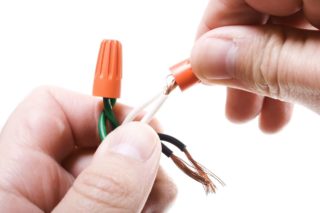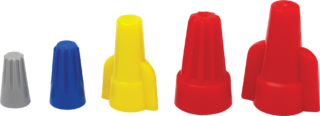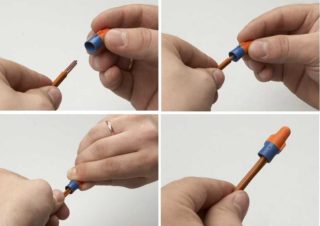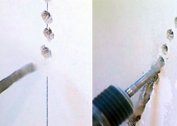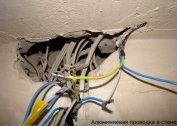PPEs for wiring are spring-type connecting insulating clamps. They are used for safe connection of cables and wires of different diameters. The main advantage due to which PPE for an electrician has become an integral attribute is high-quality insulation. It takes less time to complete and it is not necessary to have special skills or a set of tools.
Advantages and disadvantages
In order for the resulting twist to be reliable and durable, it is important to ensure maximum contact between the conductive wires - to press them tightly and tightly to each other. The clamp is equipped with a small spring, which enhances the effect. A metal spring has its own service life, over time it will weaken and the contacts with it, as a result, the wire will start to heat up.
There are many ways to isolate, but the use of PPE electrical is the leader. This is due to a large number of advantageous features.
- Quality products operate at a large temperature range, namely from -40 to +105 degrees Celsius.
- Simplicity and ease of installation - this approach saves time and budget due to the lack of the need to stock up on a set of tools.
- No additional insulation materials are required.
- Insulating PPE caps for twisting wires perform several functions - they isolate and protect electric lines from mechanical, chemical and thermal effects.
The result is a reliable, durable and practical connection. If necessary, it can be redone or completely disconnect the wires.
Despite a large number of advantages, there are also disadvantages:
- For safety reasons, it is not recommended to use PPE as the only isolation method, in its pure form.
- It is important to ensure that the dimensions of the clamp match the cross-section of the wire or cable.
- Only copper conductors are allowed to be connected. If it is necessary to connect an aluminum wire, then the PPE should be additionally equipped with antioxidant paste.
Another drawback - can not be used to install street lines.
PPE design for twisting wires
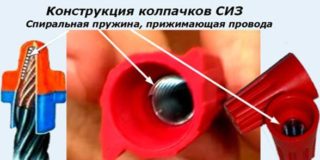 There are several varieties of connection clamps, but they all have the same design features. The part consists of a cap and a steel spring. Clamps are made of polymer alloys - plastic with electrical insulating properties. Such a substance is immune to high temperatures and is non-combustible, capable of withstanding voltages of up to 600 volts. These characteristics are usually written on the packaging.
There are several varieties of connection clamps, but they all have the same design features. The part consists of a cap and a steel spring. Clamps are made of polymer alloys - plastic with electrical insulating properties. Such a substance is immune to high temperatures and is non-combustible, capable of withstanding voltages of up to 600 volts. These characteristics are usually written on the packaging.
The spring is made of steel, it has the shape of a cone, the wire is clamped more tightly thanks to the coils. This part is additionally treated with an electrochemical protective layer.
How to choose PPE
Designs of small sizes must be selected according to the cross section of the wires. To do this, add the cross section of each wire and compare the resulting number with the data in the table below.
|
Size
|
The sum of the cross-sections of the connected wires |
Voltage
|
|
| the minimum | maximum | ||
| SIZ-1 |
1 mm2
|
3 mm.sq |
300 V
|
| SIZ-2 | 4.5 mm2 | ||
| SIZ-3 |
1.5 mm.sq
|
6 mm sq |
600 V
|
| SIZ-4 | 9.5 mm2 | ||
| SIZ-5 | 4 mm sq | 13.5 mm2 | |
Varieties
Before you go to the store for electrical clamps, it is recommended that you first familiarize yourself with their varieties.
- Standard smooth models - closed caps equipped with a spring have a conical shape, there are no “ears” and other accessories.
- Clamp with a screw tightening - not a spring is used here, but a special screw, the tightening of which can be manually adjusted from the outside.
- Insulating PPE with two holes. As a rule, such designs are used to connect grounding electrical lines. A cable is passed through the top hole to the switchboard or electrical appliance.
- Silicone-filled waterproof designs are clamps that protect electrical wires from moisture. Most often used outdoors and in high humidity.
- Antioxidant clamps - a universal design that allows you to connect copper and aluminum wires to each other.
- Low profile caps are compact parts designed to work in tight spaces.
There are PPE caps equipped with and without ears. They do not have any special differences, the only thing is that it is easier to screw a part with ears onto a cable, and PPE without them takes up less space in the junction box.
Mounting Methods
There are two ways of twisting with the use of caps: with preliminary twisting of cores and without it. If you want to connect two cables or wires, it is enough to insert them into the spring, applying force. If there are three or more wires in the wires, they must first be twisted together using pliers. After biting off the uneven ends of the wire and rotational movements, they are placed in the PPE clamp.
The winding should be done clockwise, and not against, otherwise full contact contact cannot be achieved.
The plastic cap body insulates the connection and protects the cores from mechanical stress. If the work was done correctly, additional insulation is not required.
Some useful tips
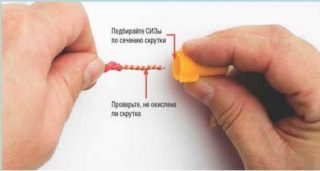 In conclusion, it is worth familiarizing yourself with several useful tips from electricians, which will help to avoid common mistakes and do the job efficiently:
In conclusion, it is worth familiarizing yourself with several useful tips from electricians, which will help to avoid common mistakes and do the job efficiently:
- It is not necessary to cut off the insulating material from the cores for a long length. It is important to first compare it with the inner length of the cone-shaped cap.
- If caps of the wrong size were chosen, as a result they will fall off the twists, which will lead to overheating of the wire and, possibly, to a short circuit.
- The color schemes of the structures are not classified or negotiated in any way, so the electrician serves the connection points as he is comfortable.
- It is forbidden to use the insulating clamps to connect aluminum and copper wires. For these purposes, there are a large number of devices, for example, special adapters with metal plates, terminal blocks and self-clamping terminal blocks.
It is important to check the cap's performance and connection quality. To do this, the maximum possible voltage is applied to the wire or cable for at least half an hour. If after this time the PPE has not warmed up, the connection is made as expected, otherwise it is worth repeating the procedure.
